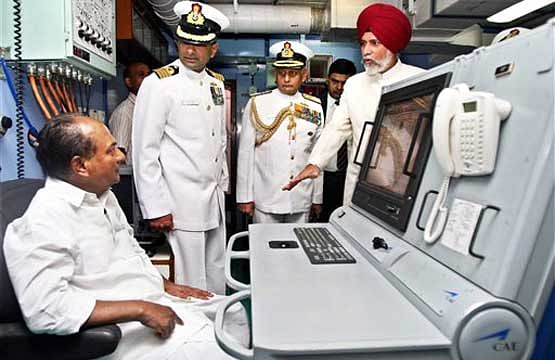

With reduced radar reflections, changed geometry of top structures, few projections on the upper deck, diminished noise vibration as well as lower magnetic and heat signatures, the 6200-kg frigate is probably the world’s largest frigate to move stealthily in the high seas.
During the sea trial, other Indian battleships ships within a radius of 100 km could not locate it on their radar. The detection range is shorter which gives the ship the benefit of launching weapons at closer range.
The weaponry includes surface-to-surface Klub missile, surface-to-air Shtil and point defence Barak missile system. It, however, does not have torpedoes and relies on Sea King attack helicopters for anti-submarine warfare.
“This is one generation ahead of the Talwar class,” said M D Suresh, captain of Shivalik, who incidentally was one of the commissioning officers for Talwar. Navy currently operates three Talwar-class ships which were purchased from Russia and placed orders for another three. “We are far better prepared now,” said Defence Minister A K Antony when asked about the state of preparedness one year after 26/11.
Measuring 142.5 mt from bow to stern, Shivalik has a range of about 5,000 nautical miles at a cruising speed of 18 knots and a complement of 257, which includes 35 officers and 222 sailors. It can be at sea for almost a month without touching a port or mid-sea refuelling.
One of the crucial new elements is its capability to operate in a nuclear, biological, chemical weapons (NBC) environment. Its air filters do not allow any outside air to come inside in a NBC zone.
“The Shivalik class will be the navy’s mainstay frigate in the first half of 21 century. It is capable of operating in multi-threat environment,” said Navy chief Admiral Nirmal Verma. All other stealth frigates in the world are smaller than Shivalik.
Two more ships of the same class, INS Satpura and INS Sahayadri, are under constructions. The first one is expected to be launched by the end of this year, and the other in 2011, said H S Malhi, chairman and managing director of Mazgaon Dock Ltd (MDL), Mumbai, that constructed the Shivalik.
As a follow up to Shivalik, the defence acquisition council has recently approved constructions of seven more similar ships, which will be manufactured by the MDL and Garden Reach Shipbuilders and Engineers (GRSE), Kolkata. Four will be manufactured at MDL and three at GRSE.
Homely food for INS Shivalik crew
Soldiers can not fight in empty stomach. And if they have to be at sea for three to four weeks, their hearts will cry for some home-made chapati or dosa, reports DHNS from Mumbai.
Maybe that’s the reason, the Navy has taken extra care to have a chapati-making machine and a dosa-maker as well as an idli maker in the galley for 222 sailors and some officers.
There is also a huge rice cooker. The ship has a fully automated galley, ensures that the crew can be fed Indian, Continental and Asian meals, including freshly baked bread and home-made ice cream, says a navy official. Two reverse osmosis plants take care of fresh water needs.
“The dosa maker can make 500 dosas in every hour,” says M D Suresh, captain of the ship. The chapati maker initially had some problems as the chapatis were thick and rubbery, which could not be eaten after half an hour.
